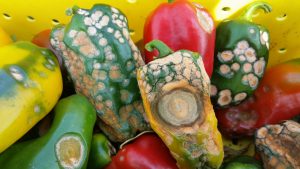The National Plant Board will be holding their annual meeting in Wilmington, DE on July 31 to August 4th. The National Plant Board plays a significant leadership role in regulation and policy rules in agricultural production with each state having a representative member. One of the topics of discussion will be Dickeya dianthicola which has caused significant problems in potato production in NJ other states in the mid-Atlantic region. There will be presentations on Dickeya and seed potato production on the morning of Wednesday August 3rd starting at 8:15 AM. More information on the meeting and the schedule can be found here.
Reminder: Dickeya discussion at National Plant Board meeting in Wilmington, DE on Weds. 8/3
Cucurbit downy mildew confirmed on cucumber in North Jersey 7-27-16
Cucurbit downy mildew has been confirmed on cucumber in Hunterdon County in Northern New Jersey. Downy mildew was found in cucumber in the southern part of the state a few weeks ago. To date, cucurbit downy mildew has only been reported in cucumber in the mid-Atlantic region. All cucumber growers who have not included a downy mildew-specific fungicide in their weekly spray program should do so. For more in formation on controlling cucurbit downy mildew please see the 2016 Mid-Atlantic Commercial Vegetable Production Recommendations Guide.
Controlling Pepper Anthracnose

Pepper Anthracnose
In recent years, pepper anthracnose caused by Colletotrichum spp. has become a significant problem on some farms in southern New Jersey.
Unlike in tomato, where symptoms are only present in mature (red) fruit, pepper anthracnose can infect pepper fruit at any growth stage. [Read more…]
‘Reba’ potato seed test positive for Dickeya dianthicola in New Jersey from Canada.
‘Reba’ potato seed (lot # 2015-3100460-022, Elite 3) certified by the Canadian Food Inspection Agency (CFIA), Grand Falls office in New Brunswick has tested positive for Dickeya dianthicola in New Jersey this summer. The same lot of seed was also shipped to PA. This is the first report of potato testing positive for Dickeya dianthicola in NJ from a Canadian source. Importantly, Dickeya-infested ‘Reba’ seed has also been shipped from different sources in Maine to multiple states in the mid-Atlantic region this year. All potato growers are encouraged to scout fields and report any suspect plants/tubers. The best method for keeping your potato operation Dickeya-free is to adopt your own 0% Dickeya-tolerance policy.
Vegetable Disease Briefs – 7/24/16
- Asparagus rust has been reported. All growers with nursery, 1-, or 2 yr-old plantings should scout regularly and apply a protectant fungicide if one hasn’t initiated fungicide program to date.
- Bacterial leaf spot in pepper has been reported in southern New Jersey.
- Cucurbit downy mildew has been confirmed on cucumber in New Jersey. All cucurbit growers need to scout on a regular basis. All cucumber growers need to add a downy mildew-specific fungicide to their weekly fungicide programs. There have been no reports of downy mildew in other cucurbit crops in New Jersey to date.
- Reports of Dickeya dianthicola in additional potato varieties continue across the east coast. Dickeya dianthicola has been confirmed in 11 states to date on potato seed originating from Maine and New Brunswick, Canada this growing season. All potato growers are encouraged to scout fields and report any suspect plants/tubers. The best method for keeping your potato operation Dickeya-free is to adopt your own 0% Dickeya-tolerance policy.
Dickeya dianthicola reported in potato in 11th state this summer
Dickeya dianthicola has been reported in potato in Rhode Island this summer. This makes it the 11th state this summer to report the pathogen in potato. The pathogen has also been detected in NJ, MA, DE, PA, MD, VA, NC, WV, and FL this year. All potato growers, crop consultants, scouts, industry representatives, and Extension personnel in states which grow potatoes should remain vigilant by scouting their fields for Dickeya symptoms on a regular basis and by submitting any suspect samples for diagnostic testing. Additionally, in recent days and weeks there has been a lot of misinformation circulating (both written and in person) about the pathogen – Dickeya, its biology, potential sources of the inoculum, and much more. All potato growers when deciding on where and from whom to buy their seed from next year need to do their own due diligence, talk with other growers [(especially those who have had the unfortunate experience with Dickeya and have received infested lot(s)] and to speak with their local Extension Service to find out the facts to help them make the appropriate decisions to avoid problems. The best method for keeping Dickeya off of your potato farm and to avoid potential loses is to adopt your own zero-tolerance policy for the disease.
For more information on Dickeya please see the following articles posted online – source(s) of information:
Dickeya: A new potato disease – Growing Produce
Blackleg is Once Again Being Observed in Potato Fields Across the Mid-Atlantic Region – Penn State University
Update on Dickeya detections in potato – University of Delaware
Dickeya Blackleg: New potato disease causing major impact. – Cornell University
Watch for Dickeya – a new potato disease – The Ohio State University
High security Aroostook farm advances tater technology. – Maine Potato Board
Slowing Dickeya, other pathogens in Canada. – North Dakota State University
Dickeya: A new threat to potato production in North America. – SPUDsmart
Dickeya is coming. – University of Wisconsin/North Dakota State University
Maine ‘Ground Zero’ for new potato disease. – Maine Department of Ag.
Maine seed potato growers looking to protect brand against disease. Maine Department of Ag./Maine
